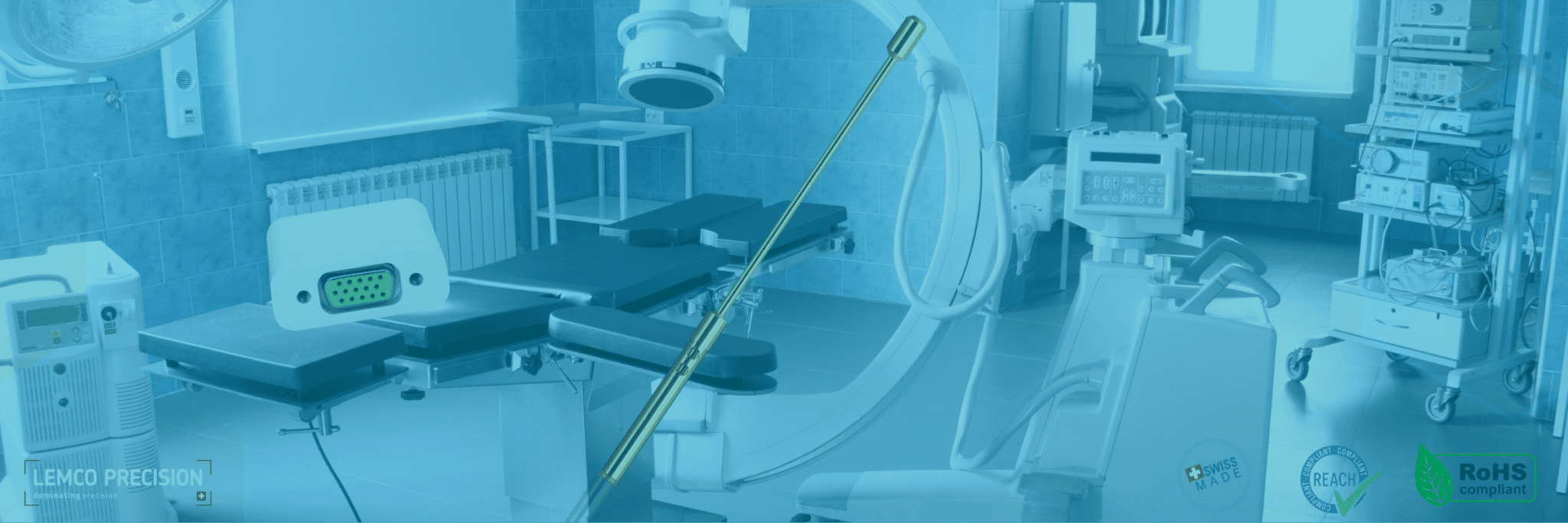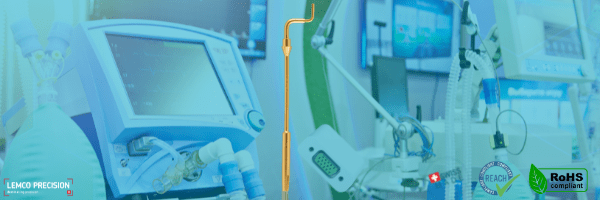Medical Connectors Need High Precision Medical Contacts for High Performance and Safety
High-performance medical contacts are a critical element in a connector assembly and contribute to the overall performance, safety, and functionality of medical equipment.

By Lemco Précision SA
Medical Contacts Used in Connectors
It’s becoming more challenging to produce medical devices that balance innovation, cost, regulatory compliance, and user-friendliness. To produce effective devices that serve the needs of patients and providers, designers must consider every element of a design, including the parts that make up components such as connectors. The smallest pins and sockets that form the contacts within a connector provide essential functionality. The materials, design, and manufacture of these parts influences the quality, safety, performance, and longevity of the final product design.
Medical devices are becoming smaller, more portable, or wearable to meet the demand for home-based care and monitoring. These designs require smaller, lightweight medical connectors that can handle greater functionality in reduced package designs. High-reliability contacts are key to providing dependable power and signal carrying capabilities.
Healthcare environments are adapting rapidly to keep up with the pace of change inspired by new diagnostic tools and internet-based services. Connected healthcare includes remote monitoring, rapid diagnostics across care teams, and connected surgical tools that integrate video, robotics, or even off-site expertise. Patients are becoming accustomed to integrating technology into every part of their lives. At the same time these groundbreaking new tools are becoming available to providers, the medical sector is facing several challenges.
- Patients are asking for remote care, better and faster diagnosis, better treatments, and less invasive procedures for diagnosis or surgeries. Medical organizations are increasingly taking patients’ comfort into consideration.
- Staff limitations during the COVID-19 pandemic necessitated home monitoring for patients via wireless technologies to track patients’ physiological parameters outside of clinical settings.
- Healthcare companies and patients are seeking lower cost care and reduced time in hospitals.
- The rising incidence of chronic diseases such as cancer, blood disorders, and autoimmune diseases is propelling the need for better diagnosis and monitoring devices.

Lemco Précision’s Winchester contact with solder bucket termination has an integrated slot-protected design. This machined monobloc contact increases the connector capability in high-density connector formats.
The medical device community has demonstrated its ability to rapidly innovate the equipment needed for 21st century healthcare. Along with forward-thinking design, quality components must be created to bring them to market. The medical technology market operates with the understanding that people’s lives are at stake. All materials in these devices, down to the smallest parts, need to be at the cutting edge of technology while also meeting strict regulatory standards that help ensure safety in people-oriented operating environments.
Considerations for Medical Contact Selection
To optimize performance in medical electronics, designers of medical connectors must select pins and sockets that meet rigorous technical specifications. Guidelines to consider include:
- Lightweight and space-saving parts that support portable and wearable equipment used in home-based care
- Copper alloys that support high performance
- Miniature contacts for scaled-down form factors
- Long and thin contacts with a small and tiny diameter
- Rugged and durable parts that resist the harsh environments medical equipment endures in use and in cleaning/sterilization
- Plating options that support reliability and performance
- Suppliers that can deliver high quality, in-house production
Other considerations may include factors such as removable parts. Medical equipment may sustain damage in the field. Rather than discard expensive equipment, well-designed devices enable effective repair. On the connector level, a component that can be disassembled and repaired offers significant value. Some designs allow damaged contacts to be replaced without changing the entire connector.

Gold plating is a common element of precision contact design, but the price of this commodity can be unpredictable. Lemco’s SWISSCOAT plating can reduce the total cost of contact production up to 20% without compromising performance and quality.
Customization Enables Innovation in Medical Contacts
The materials, production methods, testing processes, and quality measures behind an individual contact can make a difference in the ultimate success of a design in the approvals process and in the field. Contact parts must guarantee secured data, power, and signal transmission — especially critical to medical applications used in Internet of Medical Things (IoMT) devices, such as medical diagnosis applications and remote patient care.
Medical contacts can be standardized or customized, depending on the specific design and regulatory requirements of the connector they will be used in and the overall device that connector will serve. Customization is easier, faster, and more affordable than ever, with the use of modern production processes, and a versatile and experienced supplier can help evaluate the need for a fully custom part versus a modification of an existing piece.
A skilled supplier can help create complex parts for unique designs. Lemco Précision co-designed this double bent socket contact with a PCB tail termination based on client drawings. The final product enables efficient production and fast assembly; the future possibility to customize termination per client specifications; and the ability to use a monobloc contact.

A skilled supplier can help create complex parts for unique designs. Lemco Précision co-designed this double bent socket contact with a PCB tail termination based on client drawings. The final product enables efficient production and fast assembly; the future possibility to customize termination per client specifications; and the ability to use a monobloc contact.
Miniaturization
Miniature contacts support connectors that enable portability and less invasive procedures. Their smaller size and weight facilitate mobility and wearability for remote care and diagnosis devices. To deliver performance, miniature connectors must be well designed, durable, and user-friendly for handling by professionals and patients.
A nano contact by Lemco Précision. The company produces miniature, micro, and nano monobloc contacts in sizes #23 to #30, which are compact and easy to assemble in medical devices and components.
Reliability and Safety at All Costs
The crucial role of medical applications necessitates that the manufacture of medical contacts follows stringent production procedures. This includes:
- Tight tolerance to extreme and challenging conditions such as repeated mating cycles, slippery liquid, vibrations, and cleaning.
- Strict quality controls using camera inspection, combined with collaborators’ controls and customized quality controls, meet clients’ particular needs.
- Vertical in-house production. A supplier that owns and monitors the entire production line, from co-design to manufacturing, along with plating, packaging, stock, logistics, and VMI, can offer greater quality assurance.
- Traceability aligned with an agile fabrication strategy gives full transparency throughout production steps while improving safety and helping clients track products.
Lemco Précision produces high-reliability medical quality contacts in Switzerland.
Like this article? Check out our other New Technology, How to Specify, and contacts articles, our Medical Market Page, and our 2021 Article Archives.
Subscribe to our weekly e-newsletters, follow us on LinkedIn, Twitter, and Facebook, and check out our eBook archives for more applicable, expert-informed connectivity content.





